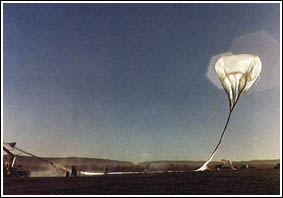Purpose of the flight and payload description
The flight became a historic one: the first slowly rotating X-ray pulsar designated GX 1 + 4 was discovered; its period was measured to be about 2.3 minutes.
Details of the balloon flight
Balloon launched on: 10/15/1970
Launch site: HIBAL - Balloon Launching Station, Mildura, Victoria, Australia
Balloon launched by: ABLS Mildura
Balloon manufacturer/size/composition: Zero Pressure Balloon Winzen 33.850.000 cuft (0.45 Mil Cap. 0.5 Mil. x 2 Stratofilm)
Balloon serial number: Serial Nº 2
End of flight (L for landing time, W for last contact, otherwise termination time): 10/15/1970
Balloon flight duration (F: time at float only, otherwise total flight time in d:days / h:hours or m:minutes - ): 10 h
Payload weight: 1423 lbs
External references
- High-Energy X-Ray Sources Near the Galactic Equator Between l^{II} ~ 335° and l^{II} ~ 350° Astrophysical Journal, vol. 173, p.L57
- High-Energy X-Ray Spectra of Five Sources Astrophysical Journal, Vol. 184, pp. 237-244 (1973)
- Stratofilm balloon flight record - in Flight Report Issue 1, 1971 - Winzen Research Inc. (StratoCat's private collection)
- Rapid Fluctuations in the High-Energy X-Ray Flux from a Source in Crux Astrophysical Journal, vol. 166, p.L73
- Review of Recent Performance of Large Balloons and Balloons with Payloads in Excess of 3000 Pounds Proceedings, Seventh AFCRL Scientific Balloon Symposium, 1973
- The Star Splitters at NASA history division
- Vast X-Ray found on constellation Centaurus News clipping from Madison Wisconsin State Journal, March 26, 1971
- X-Rays from a New Variable Source GX 1+4 Astrophysical Journal, vol. 169, p.L17
179If you consider this website interesting or useful, you can help me to keep it up and running with a small donation to cover the operational costs. Just the equivalent of the price of a cup of coffee helps a lot.


